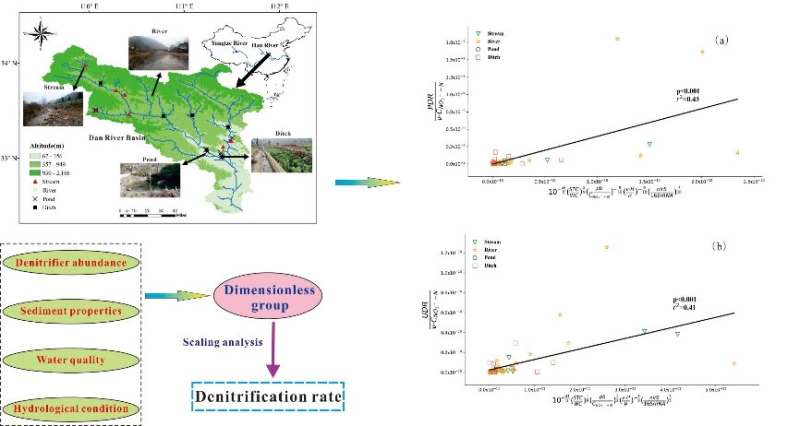A scaling analysis for estimating nitrate removal in wetlands with varying hydrologic regimes. Credit: MA Lin
Wetlands play a vital role in removing nitrogen (N) from aquatic environments via the denitrification process, which is regulated by multiple environmental and biological factors. Until now, it has been unclear how the denitrification rate responds to abiotic and biotic factors in wetlands under different hydrological conditions.
Researchers from the Wuhan Botanical Garden of the Chinese Academy of Sciences (CAS) measured the sediment potential denitrification rate (PDR) and unamended denitrification rate (UDR), and quantified denitrifier abundance in 36 stream, river, pond and ditch wetland sites along the Dan River, a nitrogen-rich river in central China.
According to the researchers, sediment denitrification rates significantly differed among streams, rivers, ponds and ditches, with the ditches having the highest denitrification rates.
Meanwhile, denitrification rates showed significant seasonality, and were negatively associated with water velocity and viscosity.
Interestingly, PDR and UDR had positive relationships with N and carbon (C) availability in streams and rivers, but such correlations were not found in ponds and ditches.
Furthermore, the relative nirS gene abundance, total C ratio, Reynolds number and interstitial space jointly provide an estimated nitrate removal in wetlands with varying hydrologic regimes.
These findings highlight that hydrological conditions, especially water velocity and hydrologic pulsing, play a non-negligible role in regulating N biogeochemical processes in wetlands.
This research was supported by the National Natural Science Foundation of China and the Youth Innovation Promotion Association of CAS.
The study is published in Science of the Total Environment, titled "Seeking the hotspots of nitrogen removal: A comparison of sediment denitrification rate and denitrifier abundance among wetland types with different hydrological conditions."
More information: Danli Deng et al. Seeking the hotspots of nitrogen removal: A comparison of sediment denitrification rate and denitrifier abundance among wetland types with different hydrological conditions, Science of The Total Environment (2020). DOI: 10.1016/j.scitotenv.2020.140253
Journal information: Science of the Total Environment
Provided by Chinese Academy of Sciences























